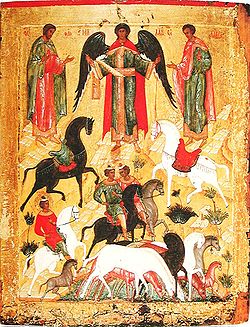Saint Florus and Laurus | |
|---|---|
 A 15th-century Novgorod icon of Sts. Florus and Laurus | |
| Martyrs | |
| Born | Byzantium |
| Died | Illyricum |
| Venerated in | Eastern Orthodox Church, Roman Catholic Church |
| Feast | August 18 |
Saints Florus and Laurus are venerated as Christian martyrs of the 2nd century. [1] According to a Greek [2] tale, they were twin brothers who worked as stonemasons. [1] They were originally from Byzantium [3] but settled in Ulpiana, Dardania, south of modern Pristina, Kosovo [4] in the district of Illyricum. [5] They were educated in the art of masonry by two men named Maximus and Proculus, [1] who were Christians. [5]
Contents
According to their legend, Likaion, the prefect of Illyricum, employed the brothers in the construction of a pagan temple. [5] The brothers gave their salaries to the poor. [5] When the son of a local pagan priest named Mamertin was injured by a chip of stone from the saints' temple, Florus and Laurus cured the boy after the boy converted to Christianity. Mamertin also decided to convert to Christianity as a result of his son's recovery. [5]
After the temple was built, Florus and Laurus brought together many local Christians there. The group smashed all of the statues of the pagan gods, and a cross was set up in the temple. [5]
The Christians spent the whole night in prayer in the converted temple. As a result of this action, the local authorities had 300 Christians, including Mamertin and Mamertin's son, burned to death. [5]
Florus and Laurus were executed in a different manner; Likaion had them thrown down an empty well. [5] The well was covered over with earth. [5]